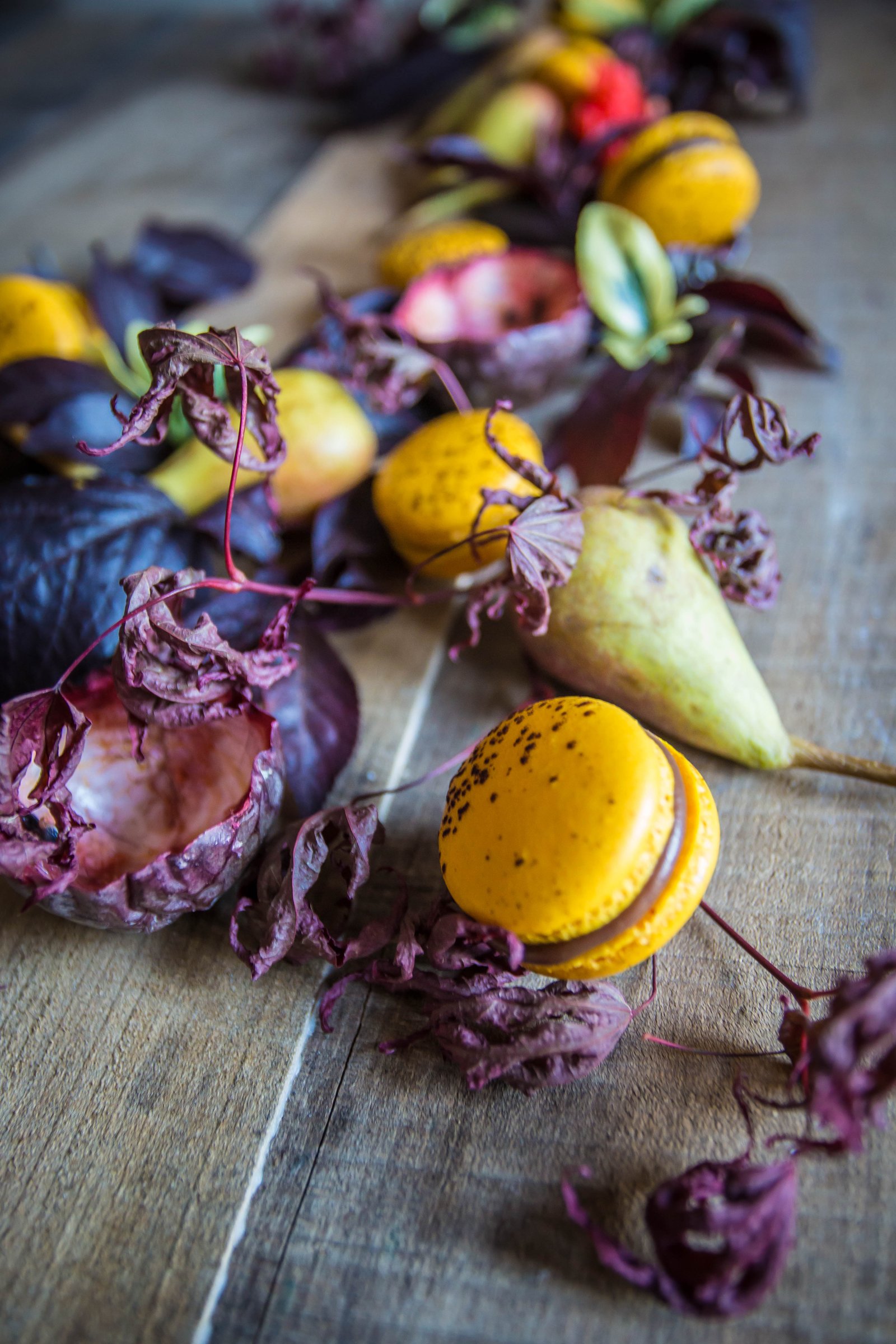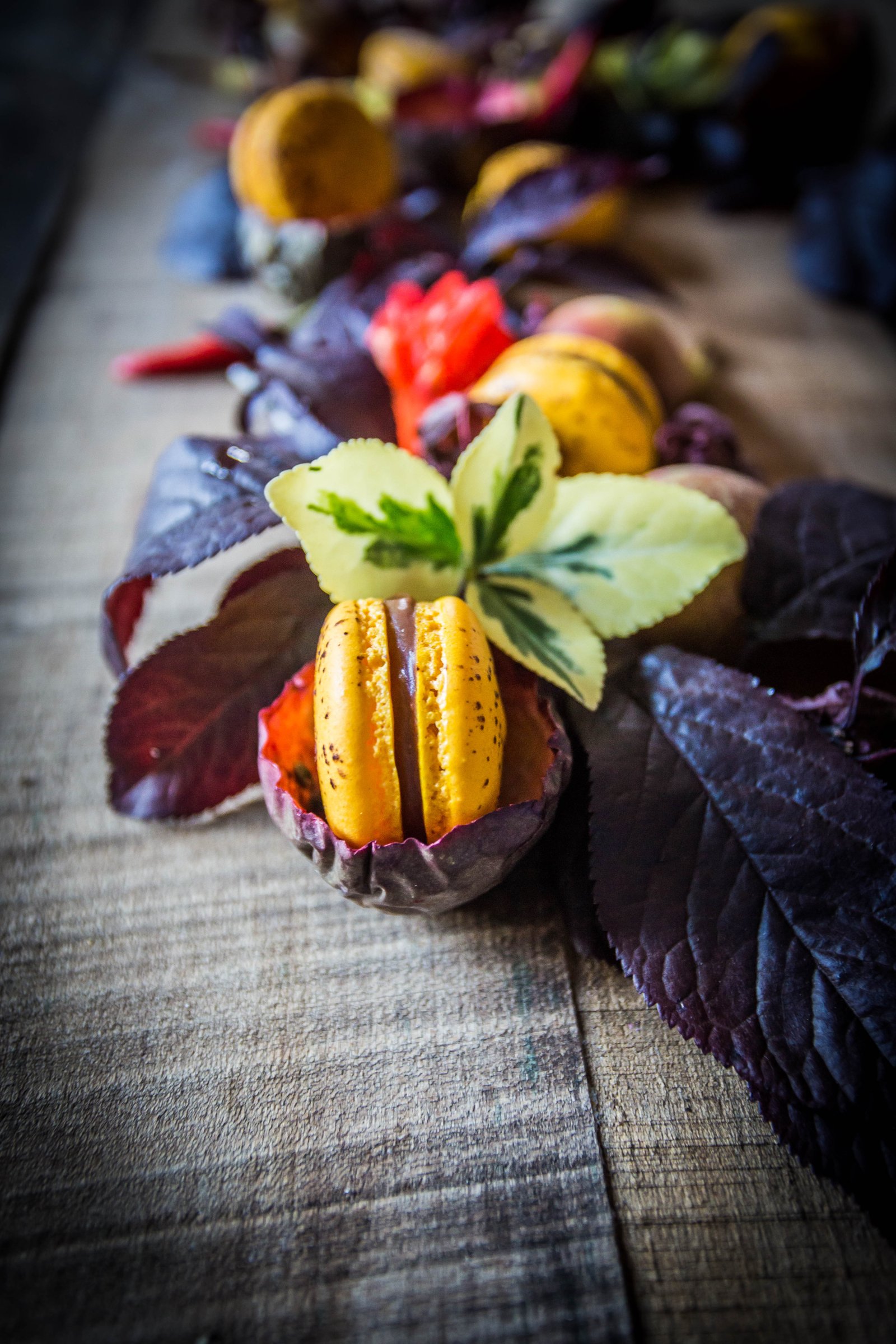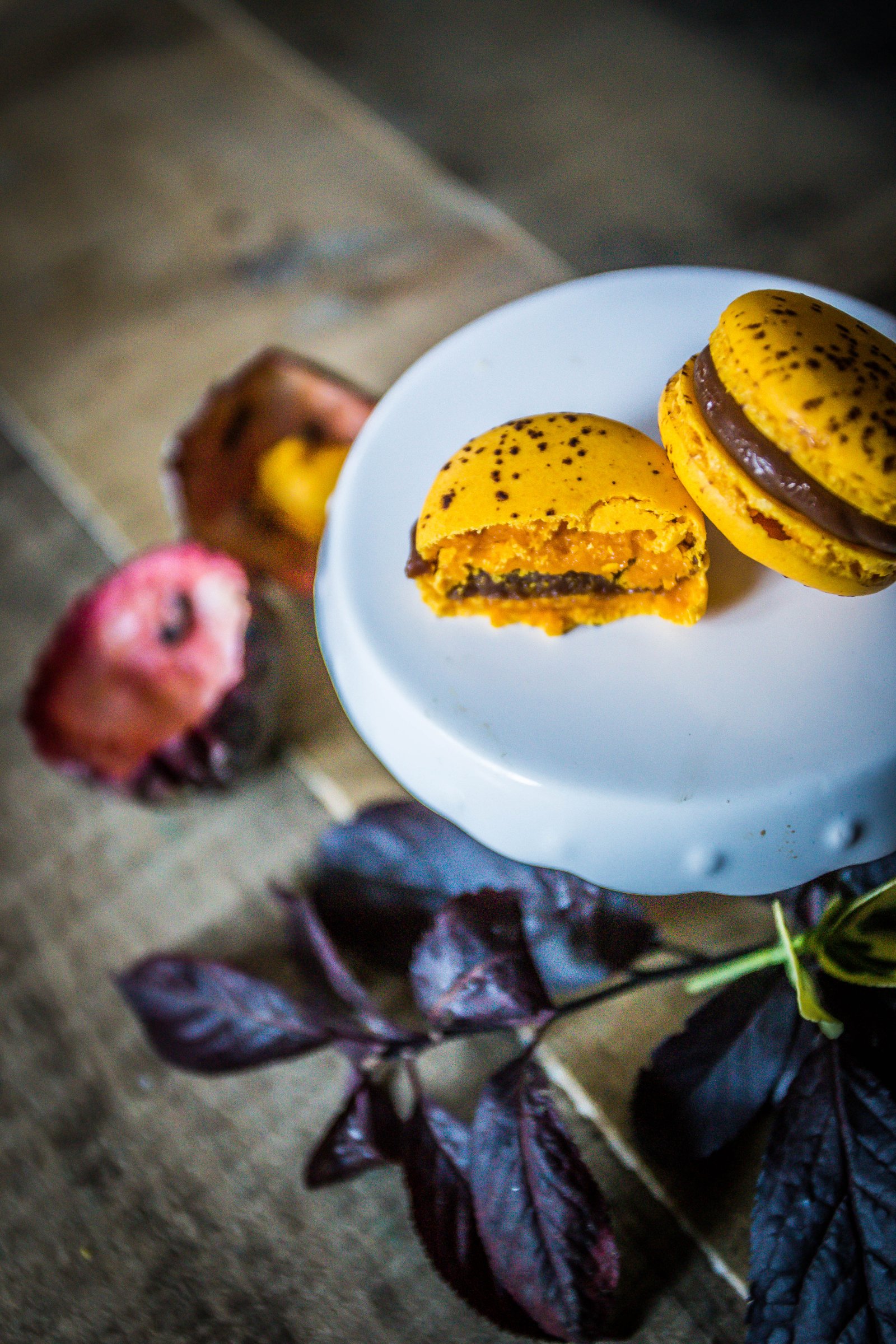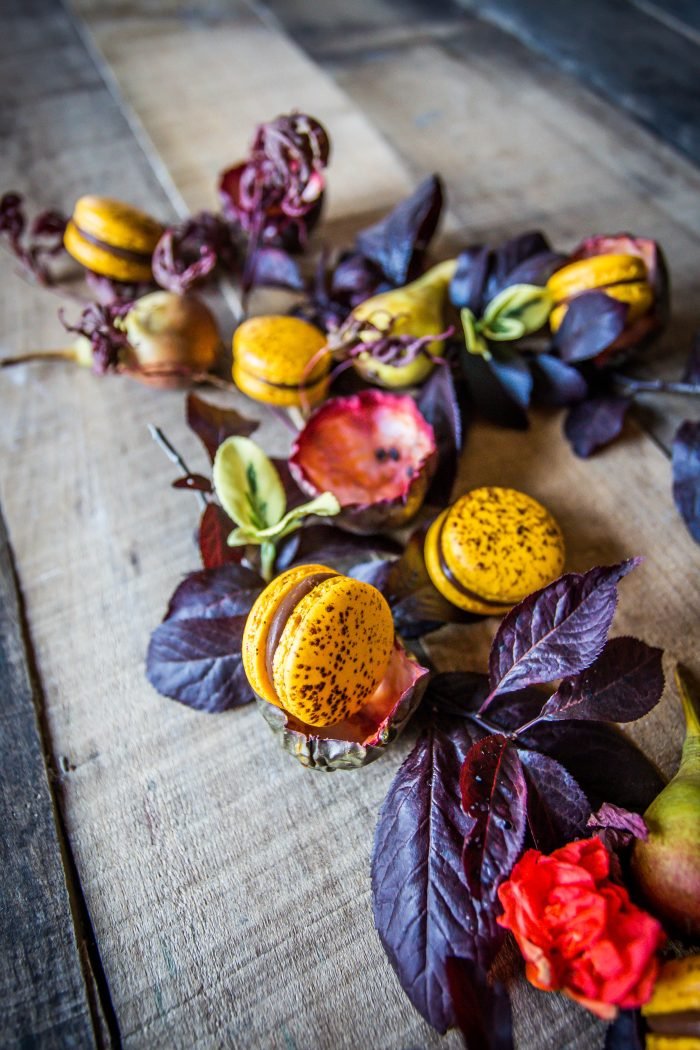(scroll down for english version)
Recentemente Pierre Hermé è stato consacrato il miglior Pasticcere al mondo da Fifty Best 2016.
Qualche minuto di applausi per l’uomo che è stato definito il “Maestro dei Macaron”, il “Picasso della pasticceria”, il “Dio-r dei Dessert”.
E pensare che alla fine degli anni ’70, mentre lavorava al fianco di Gaston Lenôtre, i Macaron non li trovava nemmeno tanto interessanti. “Sono troppo dolci“, andava dicendo.
Non solo: li trovava pure banali con le loro scontate farciture al cioccolato, vaniglia o caffè.
Però mica li ha cestinati per dedicarsi al Pain au chocolat… eh no, ha ritenuto interessante approfondire la cosa: svecchiarli, renderli ludici, goduria pura per il palato e la vista.
E così, nei lontani anni in cui io mi dividevo fra Barbie e Lego, lui aveva iniziato a ripensare completamente le vesti di questo gioiellino della pasticceria.
La creazione di un gusto nasce da un’idea, da qualcosa che ha provato, da una lettura o da un’immagine, racconta. Come il più abile stilista, pensa, disegna, scrive la ricetta e poi chiede al team di realizzarla.
I sapori sono nei suoi ricordi, il risultato già chiaro nella sua mente. Intuizione, creatività e naso che gli valgono collaborazioni con celebri profumieri, vignaioli e scultori.
Tra le sue creazioni più amate dal pubblico ci sono i Macaron all’olio d’oliva, amaretto e vaniglia, gli Ispahan che sono la perfetta fusione fra lamponi, litchi e rosa e… i Macaron Mogador: un ripieno vellutato e cremoso di cioccolato al latte che addolcisce l’acida pungenza del frutto della passione.
La ricetta dei Macaron Mogador mi è capitata sotto gli occhi proprio qualche giorno prima della sua consacrazione a migliore Pasticcere, mentre navigavo su uno dei miei siti francesi preferiti, L’Académie Du Goût.
Che piacevole coincidenza.
Ha fatto così tanto per noi amanti della pasticceria Monsieur Hermé, che mi sembra il minimo celebrarla dedicandole un post!
Dolcetto da Oscar. Credetemi, ho visto alla mia tavola bambini e adulti mangiarne anche quattro di fila.
E pensare che a 14 anni sua madre gli aveva suggerito di prendere un’altra strada.

Macaron Mogador
SUGGERIMENTI
per perfetti Macaron Mogador
1. Per queste dosi serviranno circa 3 teglie (a seconda delle dimensioni che darete ai gusci), preferibilmente microforate. Se non le avete potete usare le tradizionali leccarde. Preparate le teglie coperte di carta da forno prima di iniziare a preparare i macaron. La carta deve essere perfettamente distesa. Potete incollarla leggermente con un goccio di impasto. Non usate tappetini in silicone, non aiutano affatto.
2. Utilizzate albumi vecchi di almeno 5 giorni. Separate quindi i tuorli dagli albumi alcuni giorni prima di iniziare a preparare i macaron e conservateli in un recipiente chiuso ermeticamente in frigorifero.
Prima di iniziare lasciateli a temperatura ambiente per almeno un’oretta.
3. La farina di mandorle dev’essere finissima. É utile tostarla una decina di minuti a 150°. Questo trucco ne fa risaltare l’aroma e riduce la presenza della componente oleosa che potrebbe sbilanciare la texture del macaron.
4. Per i gusci ho utilizzato del colorante in gel della Wilton: il colore è persistente e non sbiadisce durante la cottura. Se ne avete di altre marche potete aggiungerlo gradualmente fino a che non avrete ottenuto l’intensità di colore desiderata. Sono comunque ottimi quelli in polvere e spesso preferibili perché non aggiungono umidità al composto.
5. Il frutto della passione è costoso e spesso purtroppo quelli che si trovano non hanno una grande resa in termini di succo. Quando lo scegliete tenete a mente che il frutto è pronto quando è raggrinzito, non quando il suo guscio è liscio. Ho notato che normalmente con 8 frutti riesco ad ottenere circa 125 g di succo, spremendoli bene. Per non correre rischi potete comprarne qualcuno in più e poi eventualmente congelarlo per altre preparazioni (un drink estivo o un frullato). In alternativa potete utilizzare questa e conservare in congelatore quella avanzata.
6. Riguardo alla conservazione riporto i suggerimenti del Maestro Biasetto. Il macaron può essere conservato fino a 6 mesi se mantenuto a -21°C all’interno di una scatola chiusa (anche farcito).
Potrà essere invece conservato per 7 giorni in frigorifero a +4°C all’interno di una scatola aperta oppure a temperatura ambiente all’interno di una scatola aperta il 1° giorno e poi mantenuta chiusa.
Queste sono indicazioni generali che credo poi debbano essere adattate alle specifiche preparazioni e ai diversi periodi climatici dell’anno. Io ho testato varie modalità e devo dire che i risultati sono diversi a seconda della farcitura. Una crema a base di frutta tende a bagnare più velocemente i gusci, pertanto cerco di non conservarli troppo a lungo, così come una crema al burro in estate tenderà a rovinarsi in un solo giorno se lasciata fuori dal frigorifero. Nel dubbio conservateli in frigo e consumateli entro qualche giorno.
STRUMENTI
setaccio
termometro cucina
planetaria munita di frusta fili oppure sbattitore elettrico
food processor o cutter
3 teglie (meglio microforate) coperte con tappetini microforati oppure con carta da forno siliconata
tasca da pasticcere con bocchetta liscia da 8 mm

Macaron Mogador
INGREDIENTI
Per la base macaron
150 g zucchero a velo (va bene quello confezionato)
150 g farina fine di mandorle pelate
55 g albume a temperatura ambiente
Per la meringa italiana
55 g albume a temperatura ambiente
150 g zucchero semolato
50 g acqua minerale naturale
mezzo cucchiaino piccolo di colorante in gel giallo e una punta di colorante in gel rosso (o una punta di quelli in polvere)
Per la ganache al frutto della Passione e cioccolato al latte
275 g cioccolato al latte al 40% di cacao
8 frutti della passione (per circa 125 g di succo)
50 g burro a temperatura ambiente
cacao in polvere
PROCEDIMENTO
Per i macaron
Per realizzare i macaron Mogador, iniziate realizzando il tant pou tant: mettete la polvere di mandorle a temperatura ambiente e lo zucchero al velo in un food processor, quindi azionate a impulsi alla massima velocità per alcune volte, fino ad ottenere un composto fine e omogeneo. Non scaldate il composto lavorandolo a lungo.
Setacciate la polvere ottenuta in una terrina. Questa operazione è essenziale per dare un aspetto più liscio ai gusci dei macaron.
Per la meringa italiana versate in una terrina pulita (se usate uno sbattitore elettrico) o nella ciotola della planetaria munita di frusta a fili, i primi 55 g di albumi.
In un pentolino che metterete sul fuoco a fiamma vivace versate prima i 50 g d’acqua e poi lo zucchero semolato.
Quando lo sciroppo avrà raggiunto i 90°C iniziate a montare gli albumi con le fruste a velocità molto bassa. Aumentatela gradualmente dalla minima arrivando ad una velocità media non appena inizieranno a schiumare.
Dovranno montare lentamente, altrimenti le bolle non saranno stabili e collasseranno. Dovranno essere spumosi ma ancora abbastanza morbidi.
Quando lo zucchero avrà raggiunto i 117°C, tirate via il pentolino dal fuoco e portatelo vicino alla planetaria o alla ciotola in cui state montando.
Aumentate la velocità e versate a filo lentamente lo zucchero sugli albumi che stanno mondando, facendo attenzione a non farlo schizzare sui bordi della planetaria.
Quando avete finito di versare lo sciroppo, senza spegnere la planetaria e con la meringa ancora calda, versate il colorante e appena il colore sarà omogeneo, aggiungete i secondi 55 g di albumi: lasciate lavorare la macchina per circa 20 secondi, poi spegnete. Il composto dovrà essere ancora caldo: questo vi consentirà di avere dei macaron brillanti!
Spegnete la macchina, e aggiungete in una volta la polvere setacciata di mandorle e zucchero (tant pour tant).
Lavorate l’impasto muovendolo con la spatola dal basso verso l’alto fino a quando, sollevandolo e facendolo ricadere, esso formerà un nastro. Non dovrà essere liquido ma nemmeno troppo fermo.
Questa azione, che è anche detta macaronage serve a rendere il composto liscio, morbido e brillante.
Versate il composto dentro una tasca da pasticcere munita di bocchetta liscia e, tenendola in verticale, realizzate dei piccoli bottoni distanziati tra loro sulle teglie da forno coperte con i tappetini microforati oppure della carta forno ben tesa (usate dell’impasto se necessario per incollarla).
Il diametro finale dei gusci dovrà essere di circa 3 cm. Se l’impasto è stato ben lavorato, appena l’avrete versato, tenderà a rilassarsi leggermente ma la forma sarà comunque una cupoletta.
Tenendole bene in orizzontale, sollevate le teglie a circa 30 cm dal tavolo e lasciatele ricadere con delicatezza cosicché eventuali bolle d’aria possano salire in superficie e le imperfezioni sparire.
Setacciate un po’ di cacao amaro sui gusci.
Accendete il forno a 140°C. Quando sarà caldo inserite nel centro la prima teglia e lasciate cuocere per circa 14/15 minuti. Aprite chiudete velocemente la porta del forno di tanto in tanto per far uscire l’umidità in eccesso.
Controllateli costantemente per evitare che prendano un colore ambrato.
Estraete quindi la teglia e infornate la seconda, e così via fino a terminare le teglie.
Quando la prima teglia sarà totalmente fredda, staccate i gusci aiutandovi con una spatola piatta da pasticceria.

Macaron Mogador
Per la ganache al Frutto della passione e cioccolato al latte
Tagliate il burro in piccoli pezzi e riducete il cioccolato in scaglie con l’aiuto di un coltello. Tagliate il frutto della passione in due e ricavatene il succo con l’aiuto di uno spremiagrumi. Filtratelo e versatelo in un pentolino che metterete sul fuoco.
Mettete il cioccolato in un pentolino e fatelo sciogliere a bagnomaria. Quando sarà fuso versatevi il succo caldo del frutto della passione in tre volte mescolando con una frusta.
In questa fase è normale che la ganache si separi leggermente (le molecole della materia grassa contenuta nel cioccolato si separano). Continuando a mescolare energicamente il tutto diventerà omogeneo e otterrete una ganache brillante e vellutata.
Quando la temperatura avrà raggiunto i 60°C incorporate i pezzetti di burro. Mescolate bene poi coprite con pellicola alimentare e riponete in frigorifero affinché prenda la giusta consistenza. Versatela quindi nella sacca da pasticcere munita di bocchetta liscia (da 8 mm può andare bene) e dosatene una noce abbondante sulla metà dei gusci. Chiudete con le altre metà e ponete i macaron al frutto della passione e cioccolato al latte in frigorifero almeno per una notte prima di servirli.
Estraeteli dal frigorifero almeno un’ora prima di consumarli (in estate è sufficiente anche meno).

Macaron Mogador
***
english version
Macaron Mogador – Celebrating Pierre Hermé
Recently Pierre Hermé has been awarded World’s Best Pastry Chef 2016 by Fifty Best.
A few minutes’ applause for the man who has been described as “The Master of Macaron”, the “Picasso of Pastry”, the “Dior of Desserts”. And to think that, towards the end of the 70s, while he was working with Gaston Lenôtre, he wasn’t even too bothered with Macaron. “They are too sweet” he used to say. And not only that: he found them ordinary, with their predictable chocolate, vanilla or coffee fillings. However he didn’t abandon the idea to devote himself to Pain au chocolat; no, he decided to get to the bottom of the issue: renovate them, make them shiny, pure heaven for the eyes and the palate. And so, in years gone by, while I was busy with Barbie and Lego, he began to invent a whole new life for this jewel of the pastry world. The creation of a shell begins from an idea, something he tried, something he read, or from an image, he tells us. Like the most skillful stylist, he thinks, designs, writes the recipe and then asks his team to create it. The flavors are in his memories, the final result is already well defined in his mind. Intuition, creativity and a fine nose brought him collaborations with famous perfume-makers, wine-makers and sculptors. His most beloved creations include flavors such as olive oil, amaretto and vanilla, Isfahan – a perfect combination of raspberries, litchi and rose – and Mogador: a creamy, velvety milk chocolate filling to sweeten the pungent sharpness of the passion fruit.
I happened to see the Mogador recipe just few days before his World’s Best Pastry Chef award, while browsing one of my favorite French websites, L’Académie Du Goût. What a pleasant coincidence.
You’ve done so much for us pastry-lovers, Monsieur Hermé, that celebrating you with a post seems the least I can do.
A dessert worth an Oscar.
Believe me, I saw at my table children and adults eating up to four of them in a row.
And to think that, when he was 14, his mother suggested him to do something else…
TIPS for perfect Macaron Mogador
1. For these quantities you’ll need approximately 3 trays (depending on the size of the shells), preferably microperforated. If you don’t have any, you can use the normal trays. Line them with baking paper before beginning to prepare the macaron: the paper must be perfectly flat. You can make it adhere lightly with a drop of batter. Do not use silicon mats, they do not help at all.
2. Use egg whites that are at least 5 days old. Separate the yolks from the whites a few days before starting to prepare the macaron, keeping them in a sealed container in the fridge. Before starting, leave them at room temperature for at least one hour.
3. The almond flour should be finely grounded. It is useful to roast it at 150° for about 10 minutes. This trick enhances its aroma and reduces the oily component, which could unbalance the macaron texture.
4. For the shells I used some Wilton icing color: the color is persistent and doesn’t fade during baking. If you have a different brand, add it gradually until you obtain the right shade of color.
5. Passion fruit is very expensive and often, unfortunately, the fruits you find around are not very juicy. When you choose them, keep in mind that the fruit is ripe when it is wrinkled, not when its shell is smooth. I reckon that usually with eight fruits I can get about 125g of juice, if I squeeze them well. To be on the safe side, you can buy a few more and in case you can freeze any left over for other recipes (like a summer drink or a smoothie).
6. When it comes to storage, here are the recommendations of Master Biasetto. The macaron can be stored for up to six months as long as it’s kept at -21°C in a sealed container (even with the filling). Otherwise, it can be kept for up to 7 days in the fridge at +4°C in an open box, or at room temperature if the container is open for the first day, and then kept closed. These are general guidelines that, in my opinion, should then be adapted to the specific preparations and different climatic periods of the year. I have tested various methods and I must say that the results are different depending on the filling. A fruit-based cream tends to wet the shells faster, so I try not to keep them too long. Similarly, a butter-based cream in summer will be ruined in one day if left out of the refrigerator. When in doubt, keep them in the fridge and eat them within a few days.
TOOLS
Sieve
Food thermometer
Food mixer or Kitchen machine with wisk attachment, or electric beater
Blender
3 trays lined with baking paper
Piping bag with plain round 8mm nozzle
INGREDIENTS
For the macaron base
150 g icing sugar
150 g peeled almond flour, finely grounded
55 g egg whites at room temperature
For the Italian meringue
55 g egg whites at room temperature
150 g granulated sugar 50 g still mineral water yellow icing colour – half of a small teaspoon
red icing colour – the tip of a teaspoon
For the passion fruit and milk chocolate ganache
275 g milk chocolate with 40% cocoa
8 passion fruits (125 g juice)
50 g butter at room temperature
Cocoa powder
METHOD
For the macaron
Add the almond flour, at room temperature, and the icing sugar in a food processor or blender and pulse at the maximum speed for a few times, until you obtain a fine and uniform mixture. Do not heat the mixture in the process. Sift the mixture into a bowl. This is essential to give a smooth appearance to the macaron shells.
For the Italian merengue, pour the first 55 g of egg whites into a clean bowl, or the bowl of the food mixer with the wire whip.
Place 50 g of water into a small saucepan on high heat and then add the granulated sugar. When the syrup reaches 110°C, start to beat the egg whites on medium speed. They must be fluffy but still quite soft. When the sugar reaches 117°C, remove the saucepan from the fire and bring it near the food mixer or the bowl. Bring the speed to minimum and pour half of the syrup all at once; then raise the whip speed to maximum for a few seconds. Slow down the speed again, add the second half of the syrup and whisk on high, continuing to beat the eggs until they cool down to 50°C.
With the whip still beating, add the second 55 g of egg whites and the icing color and mix just as long as it takes to combine well all ingredients.
Turn off the food mixer and add the sieved almond flour and sugar mixture (tant pour tant). Gently fold together with a spatula moving from the bottom to the top until the batter falls in thick ribbons from the spatula. It shouldn’t be liquid, but not too hard either. This process is also known as macaronage and ensures that the batter is smooth, soft and shiny.
Pour the mixture into a piping bag with 8mm nozzle and, keeping it straight, create small rounds of batter on the trays lined with baking paper. The final diameter should be approximately 3 cm. If the batter is done right, once on the tray it should expand slightly. Carefully keeping the trays horizontal, lift them at approximately 30/40 cm from the table and let them fall; in this way any air bubbles will be brought to the surface, avoiding imperfections. Sieve a little bit of cocoa on the shells.
Heat the oven to 150°C, add the first tray in the mid section and let the macaron bake for approximately 13/15 minutes. Check them constantly to avoid them turning to an amber color. Remove the first tray and add the second one, and so on until you’ve baked all macarons. Once the first tray is completely cooled down, gently peel the macarons off the paper with the help of a flat spatula.
For the passion fruit and milk chocolate ganache
Cut the butter into small pieces and the chocolate into flakes with the aid of a knife. Halve the passion fruit and extract the juice using a citrus juicer. Strain it and pour it into a saucepan that you will put on the fire. Place the chocolate into a small saucepan and let it melt in a bain-marie. Once melted, pour the hot passion fruit juice onto it, in three times, stirring with a whisk. At this stage it’s normal for the ganache to be uneven (the molecules of fat in the chocolate are separating). By continuing to stir vigorously, the mixture will become smooth and you’ll obtain a silky, shiny ganache.
Once the temperature reaches 60°C, add the butter chunks. Incorporate well, cover with cling film and place in the fridge in order to obtain the correct consistency.
When ready, pour it on the piping bag with plain round nozzle (8 mm will do) and place some (approximately the size of a walnut) on half of the shells. Close with the remaining shells and leave the macaron in the fridge at least overnight before serving them.
Take them out of the fridge at least one hour before serving (or less if it is summer).







Nessun commento